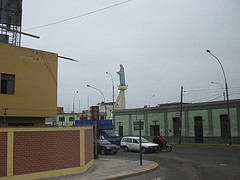
Religious sculptures and churches towered over most of Lima’s low buildings
I spent a lot of this trip to Peru and Ecuador trying to wrap my mind around the fact that I was really where I was. Some of this was because we hadn’t done the planning ourselves. We were tagging along with my brother and sister-in-law, Barry and Louise. Louise had done all the work.
We were the only Americans (besides Barry) in a group of Canadians, and we spent the trip wearing a maple leaf on our group identity badges. We heard a lot of self-deprecating Canadian jokes. Since self-deprecating American jokes are kind of oxymoronic, we didn’t attempt to reciprocate.
The airport in Lima is a thing of beauty, a 21st century structure; the red caps wore little patterned hats with ear flaps and little patterned vests. The contrast between modernity and the past was disconcerting.
I couldn’t get over the third-world little stuccoed boxes that served most of Lima as dwellings and businesses. People left rebar exposed on the top of the buildings, in expectation that at some future time–when they got more money or their family grew in size–they’d add another layer of building. The bristling rooflines gave the buildings a scruffy look of dashed expectations.
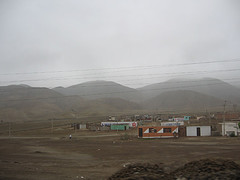
Poor housing along the desolate coast
The coastal land south of Lima until Ica along the Pan-American Highway was desolate, with occasional hovel cities as well as a few small towns. Big business agriculture was starting to develop some of the land, but mostly I saw miles of empty desert.
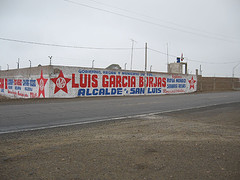
a campaign poster painted on a fence
Because it was a pre-election period, campaign posters were all over. Some in Lima were familiar–on billboards–but many were painted onto fences and houses, or even marked onto the sides of hills. These stood out along the otherwise brown landscape south of Lima.
Nazca Lines
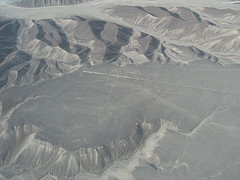
Nazca Lines hummingbird; it’s a little hard to see at this size, so click on it for the blow-up
In Ica, we took a small airplane–a 12-seater–up to view ancient, giant drawings on the land, believed to be about 2000 years old. The drawings are too large for land-bound humans to view. I wondered what technique the ancient people or person used to transfer the outline into such a large scale. We all wondered what inspired them–and who they were for.
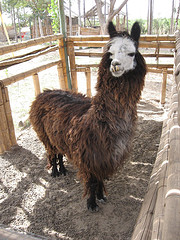
an alpaca in the little zoo behind the airport
At the airport, a young artist of today put up a display of paintings. His name was Dante Guevara Bendezu, and work similar to his by another artist was on display in our hotel. Check out his web site!
Earthquake
The next morning after the flight, we were awakened by the earth shuddering. At first I thought it was a couple of llamas out on the walkway, having at it (what a dreamer!), but then I woke up and headed for the doorway. Murray just wandered around taking it all in, refusing to acknowledge any danger. Fortunately, our hotel stayed standing. According to the newspapers, only an evangelical church collapsed, no one inside.
While we were a bit shocked by the earthquake, a 6.2 with a nearby epicenter, our guide shrugged it off as a weekly occurrence. It certainly didn’t make big news beyond Peru. Later that day, our guide took us to visit an Inca site named after the earth god. Appropriate.
The Sacred Valley
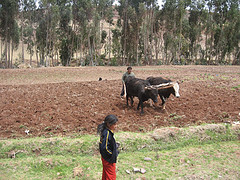
Farming with oxen in the Andes
And speaking of danger, the moment we arrived in Cusco, I got altitude sickness and slept for 24 hours. A couple of days later, some more in our party came down with symptoms. It was unclear how much was altitude, how much Montezuma’s revenge.
Cusco and the highlands were the Peru we had imagined, with local women in layers of skirts, knee socks and bowlers, short men with dark straight hair, mountains and small farms, terraced land and tiny little fields located wherever the mountain would permit farming.
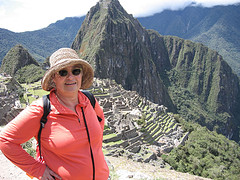
me at Machu Picchu (Murray took the picture)
Between tourism and agriculture, this highlands section of Peru was relatively prosperous and beautiful. We were also dazzled by the traditional handicrafts–especially the textiles. The crafts were the highlight as far as art goes. I did go on a hunt for contemporary art in Quito, but came up pretty dry (although I did get lost several times during the day–and got rescued once by a couple of women who gave me a lift to where I was going). For images of what I did see, you can find them on my Flickr set of the trip.
Also on the Flickr site, check out the chicharia, the bar that sold chicha, or corn beer, an ancient drink going back to pre-Inca civilizations. It’s an acquired taste. With strawberries added, however, it’s pretty good.
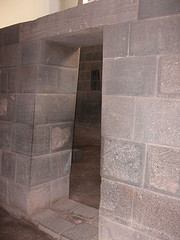
Inca stone work and typical trapezoidal door at Qorikancha, a ruin incorporated into a convent
The Incas were the Romans of this region. They conquered others, took the best of the methods, and organized those they conquered to build amazing fortresses, pyramids, places of worship, all out of stone. The terracing techniques and water management techniques seemed to have preceded the Incas, but they were smart enough to adopt them and elaborate on them. Their engineering and stone-cutting techniques were extraordinary–creating dry stone walls with perfect fits of irregular shapes that resisted earthquake damage. The walls also got narrower as they rose–another earthquake-resistant feature.
Transportation
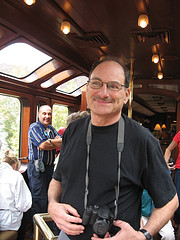
Barry in the observation/bar car on the Hiram Bingham luxury train
Transportation via the train to Machu Picchu and via the small cruise ship and Zodiac rubber dinghies for landing on the Galapagos Islands were highlights of the trip. The crazy train ride we took to Machu Picchu on the Hiram Bingham train (5-course meals, slow-slow ride, fabulous scenery, brass fittings, etc.) was out of another era. The train was named after Hiram Bingham, the American who brought news of Machu Picchu back to the greater world. (Some local Indians already knew about it, our guide German pointed out).
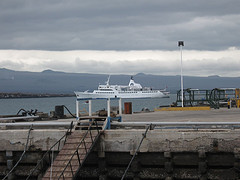
the M/V Galapagos Legend, our cruise ship
As for the Galapagos cruise, besides the tiniest cabins (helful if you don’t have your sea legs), we got two trips a day to the islands, where the animals were in touching distance–giant tortoises, sea lions, various birds including blue-footed boobies (my personal favorite), fish (we snorkeled) and loads of crabs and iguanas.
Galapagos
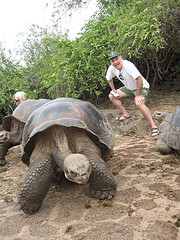
Murray and a giant tortoise at the Charles Darwin Research Station
Most stunning to me were the way the Galapagos are far from pristine, with paths for tourists like us, with a city and an airport. Our guide, Charlie, was born on the Galapagos! People live there. I have lots of great turtle shots from inside the hatchery where they are trying to breed animals threatened with extinction. Even my turtles in “the wild” really were on a sort of farm. Most amazing were the numbers of them.
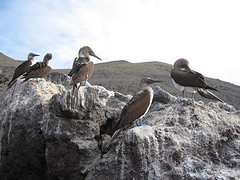
Blue-footed boobies. Their feet are baby blue and look almost plastic.
I don’t know how I could have been surprised at how developed the islands are. After all, going there has become quite the tourist industry–proof being that even I went there. But I enjoyed myself anyway. It was (for me) an adventure every time I got on the little landing craft. My best ride was the one I took myself because everyone else had left without me. With me, the boatman and a guide, we flew across the water on my Lamborghini of Zodiac inflated boats, queen of the Galapagos.





